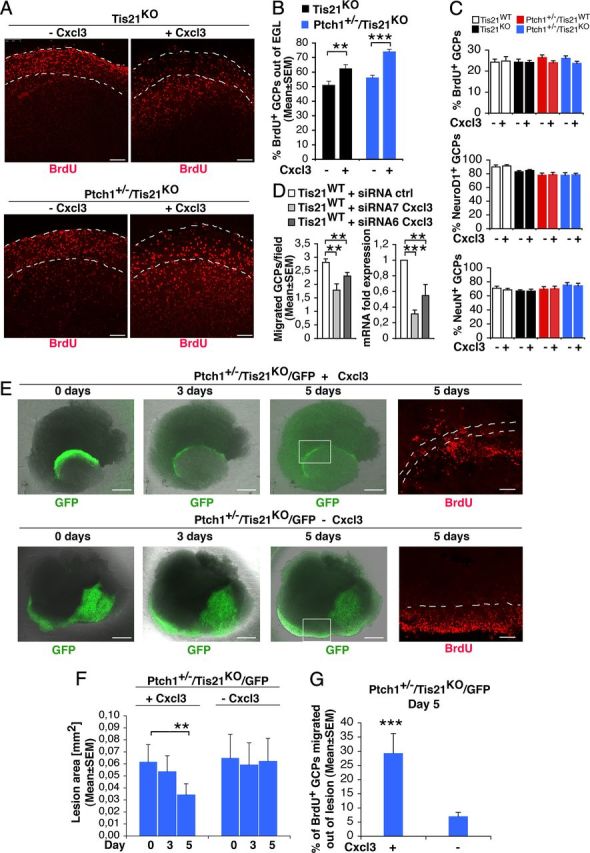Figure 9.

Cxcl3 rescues the defective migration of GCPs outside the EGL or outside lesions, and reduces the area of lesions in Patched1 heterozygous/Tis21 knock-out mice. A, Representative confocal images of cerebellar organotypic slices from Tis21-null/Patched1 wild-type or heterozygous mice treated with or without Cxcl3, showing BrdU+ GCPs inside or outside the EGL (indicated by a white broken line). Scale bars, 100 μm. B, Quantification of BrdU+ GCPs migrated outside the EGL. Slices from P7 mice were cultured 5 d with or without Cxcl3 (adding BrdU at t0 for 18 h), fixed, and immunostained with anti-BrdU antibody. Shown is the mean ± SEM percentage ratio between BrdU-positive cells outside EGL and total number of BrdU-positive cells (from 3 experiments; 3 mice per genotype were analyzed). **p < 0.01 or ***p < 0.001, Student's t test. C, Quantification of proliferating (BrdU+) or differentiating (NeuroD1+ or NeuN+) GCPs in the EGL after treatment with Cxcl3. Slices from P7 mice were cultured 48 h with or without Cxcl3 (adding BrdU 2 h before analysis), fixed, and immunostained with antibodies against BrdU, NeuroD1, or NeuN (mean ± SEM percentage ratio between BrdU+, NeuroD1+, or NeuN+ cells in the EGL and total number of cells, from 3 experiments; 3 mice per genotype were analyzed). D, RNAi knockdown of Cxcl3 in GCPs leads to inhibition of their ability to migrate (graph on the left). Purified GCPs from wild-type P7 rat cerebella were transfected by electroporation with siRNAs targeting Cxcl3 (either siRNA7-Cxcl3 or siRNA6-Cxcl3) or with a control siRNA; immediately thereafter, GCPs were seeded (6 × 106) onto 35 mm dishes in recovery medium (with high serum) for 3 h, and then transferred in the upper part of a modified Boyden chamber. After 16 h, the GCPs migrating to the lower side of the membrane were counted. Mean cell number per field ± SEM were obtained from three separate experiments, counting 20 fields per well (at least 2 wells per experiment). The graph on the right shows the levels of Cxcl3 mRNA in the same preparations of purified GCPs transfected for migration tests (mean ± SEM fold increases; TBP was used to normalize data). **p < 0.01, ***p < 0.001, Student's t test. E, Representative confocal images of diffuse hyperplasia lesions in cerebellar organotypic slices treated with or without Cxcl3, from Patched1 heterozygous/Tis21-null mice (Ptch1+/−/Tis21KO/GFP) at 4 weeks of age, showing GFP+ GCPs inside the lesion (green), and a magnification of BrdU+ GCPs (red) migrating outside lesions (bordered by white broken line) in the presence or absence of Cxcl3. Scale bars: 500 or 100 μm for GFP or BrdU panels, respectively. F, G, Quantification of lesion area (F) and percentage of BrdU+ GCPs migrated outside the lesion (G). Slices obtained from P42 mice were treated with Cxcl3 for 5 d and pulse-labeled with BrdU added at t0 for 18 h, fixed, and immunostained with anti-BrdU antibody. Data are mean ± SEM from three experiments (3 mice per genotype were analyzed). **p < 0.01 or ***p < 0.001, Student's t test.
